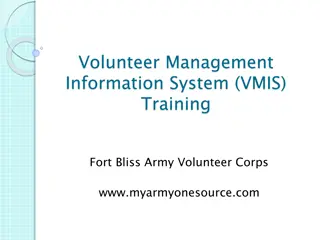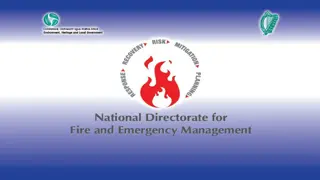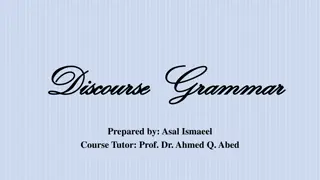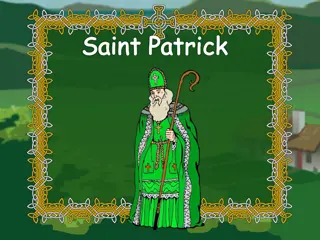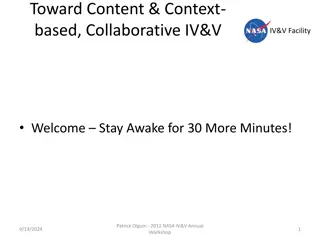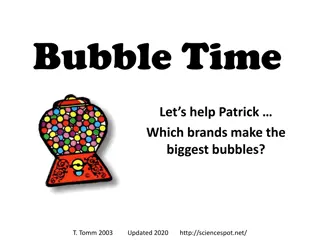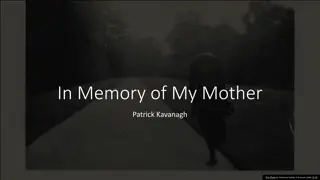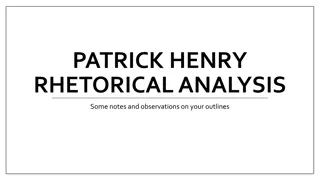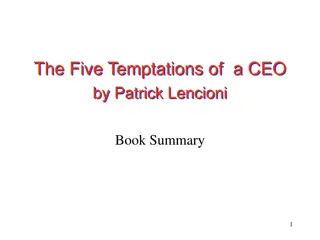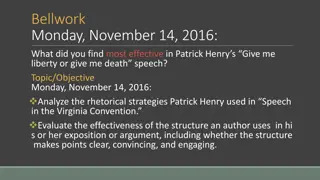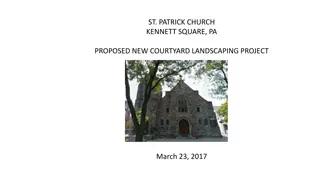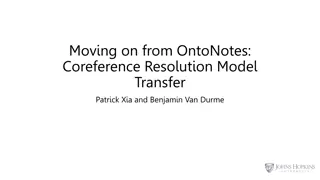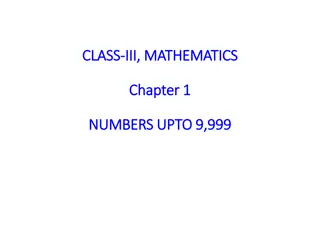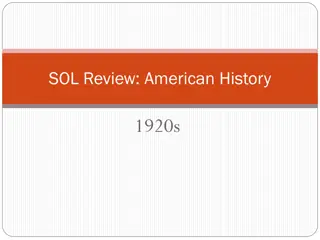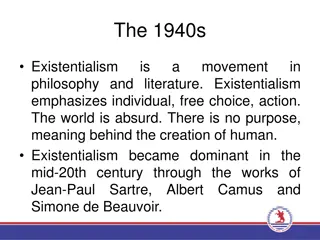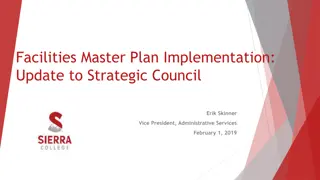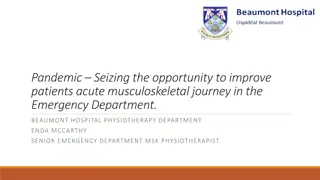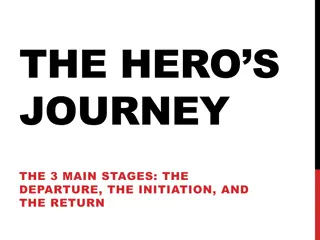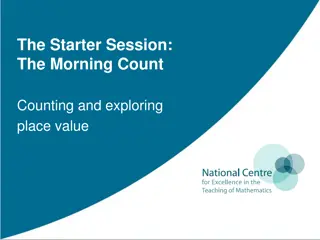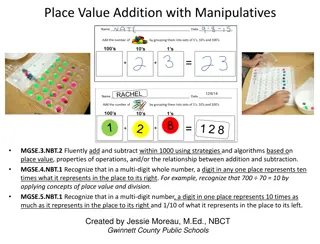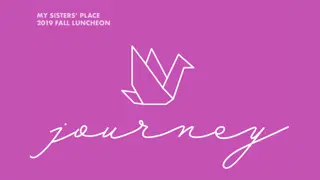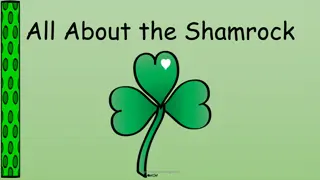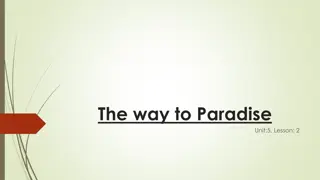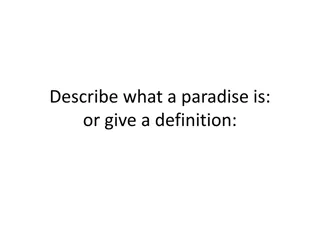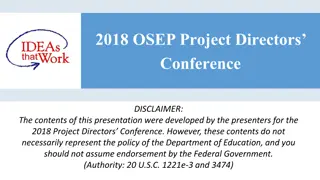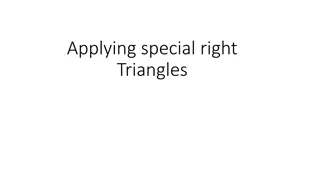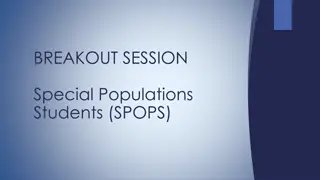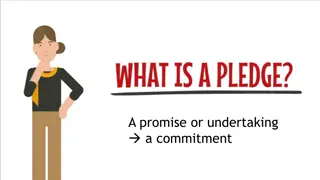Experience Your Own Special Place of Bliss with Dr. Patrick McCarthy
Discover how to induce a state of deep relaxation and create your unique special place of bliss through a guided visualization exercise by Dr. Patrick McCarthy. Follow the steps to imagine a corridor, visualize a door, and unlock the potential of your mind to experience absolute bliss. Embrace the power of trance induction and inner exploration through this transformative journey.
Download Presentation

Please find below an Image/Link to download the presentation.
The content on the website is provided AS IS for your information and personal use only. It may not be sold, licensed, or shared on other websites without obtaining consent from the author. Download presentation by click this link. If you encounter any issues during the download, it is possible that the publisher has removed the file from their server.
E N D
Presentation Transcript
The Special Place of Bliss By Dr. Patrick McCarthy dr.pat@medicalhypnosis.co.nz
Induction of trance. (Usually using the McCarthy index fingers 2 finger attraction method) Hands in prayer-like position. Cross thumbs. Intertwine fingers. Extend index fingers. Wait till they touch. Close eyes. Deep a deep breath and as you breathe out feel the deep relaxation flowing through the body.
Today Id like to teach you how to experience your very own unique special place of bliss ..(pause) I d like you to imagine a corridor. As you walk along the corridor there are doors leading off to the left and to the right. (this promotes lateral eye movement) At the end of the corridor is a door. A very inviting sort of door. ( Inviting is an unusual adjective to describe a door but essential to avoid possible unexpected abreaction. Never suggest a color, always let them choose. An inviting door is one that you would wish to enter.)
You can decide for yourself the size and shape of the door. (Freedom to choose) Tell me, what color is the door? (Wait for an answer to each of this and the following questions)
Is the door a plain door or does it have panels? Does the door have a handle? Is the handle on the left or on the right? What colour and shape is the handle? Now look very closely, does the door seem to open inwards or outwards? (Answering these questions establishes that the subject is actively visualizing a particular door. Imagining a door is not a difficult task for anyone and if someone claims to be unable to see a door then do NOT proceed with this exercise. I have only ever had one person claim to be unable to imagine a door despite using this exercise with several thousand patients. She had aphantasia.)
You may be wondering about this door? (Indirect suggestion to wonder) About what lies behind the door? (further wondering) In a few minutes (not now but later) you will discover that behind the door is a special place. Your very own special place. A place that your imagination is already creating for you. (You do not have to be consciously aware of it now) It is a special place. A place of bliss. Absolute bliss!
Now bliss is an old fashioned word. (Truism) It s not used much nowadays. (Truism) Let me be quite clear about what I mean by bliss. Bliss is a state of mind. (Truism) Bliss is far more than just the absence of negativities. (Truism) The absence of worries, the absence of problems, concerns, difficulties, traumas and upsets. (Truism) Bliss is far more than just that. (Truism) As well as the absence of negativities, bliss is also the positive presence of such concepts as freedom, peace, comfort, joy, happiness, relaxation and rest. (Helpful suggestion spoken as if every word is also a truism. 6 truisms followed by a helpful suggestion is called a YES Set.)
Absolute pleasure....sheer.....bliss. So*,in order to experience a sense of bliss then we have to, at least on a temporary basis, be able to put all of our problems and worries and concerns off to one side. (Another helpful suggestion said as a truism) So, (so* is a very handy segue or link word even when there is no obvious linkage) on your back you will find a backpack.
Take the backpack off and place it in front of you. (Direct suggestion) Open the backpack. (Direct suggestion) Inside you will find a collection of stones. Special stones. Notice how the stones are somewhat flat, but rounded and smooth, rather like the sort of stones you might find on the bed of a river or a rocky beach perhaps......... Do you see the special stones? (Wait for confirmation)
These stones are special because in hypnosis they are very symbolic. The stones represent all of your particular problems. Every problem. Every concern. (That s a very important reframe - problems are now stones)
And because these stones represent every problem, not just the ones that you have told me about. I want to make one thing very clear. The next part of the exercise will be carried out in total and absolute privacy. (Reassurance) Now by total and absolute privacy, I don t just simply mean the normal confidentiality that you would expect and will of course receive from a doctor. (Further reassurance) No, I mean far more than that. (Even better) By total and absolute privacy I mean that you will do the next part of the exercise entirely inside your own head, in silence. (No disclosure) So that only you will ever know what particular issues these stones represent for you. Let me be absolutely clear. (Further reassurance)
I will never, ever, ask you to talk about the meaning of your stones. (Unvoiced therefore ) Only you will ever know how many stones are in the backpack. Again I will never, ever ask you to talk about the number of stones. And perhaps most importantly of all only you will ever know the weight of each particular stone. Obviously (an authority word that actually usually means not obvious ) the weight of the stones relates to the weight of the problems. Again I will never, ever ask you to talk about the weight of any of the stones. Is that guarantee of privacy completely understood? (Wait for a nod or other indication of confirmation)
These stones represent all of the problems that you have in your mind. There are the problems of now, the present. The issues and concerns that are on your mind now, today, this very day. But there are also stones about the past. And the past includes yesterday, last week, last month, last year, ten years ago, many years ago. All the way back to your earliest memories of problems from childhood.
And there can also be stones from the future. How can this be since the future hasn t happened yet? Well, these are what I call the What if? stones. Some people carry around stones that represent worries about what might happen in the future. What could go wrong! What might not change! (Exclamations and not questions) Sometimes these stones are possibilities. Sometimes remote possibilities. But some people carry them around like rocks of probabilities. (Linked by the -illities) Or even as huge boulders of certainties.
Your imagination will tell you what size each stone and issue is. (It will happen automatically you do not need to choose) Now look at the stones in the backpack. (Visualize) This is what I want you to do. (Listen carefully) In a few moments I will give you the signal to start emptying the backpack. This is how I want you to empty it. (Instructions coming up)
In a moment I want to you look at the top stone. It will probably have a label on it. (It may not!) To let you know what problem it represents. I want you to read the label and identify the problem. Then, briefly, (Briefly is extremely important! It minimises any possible abreaction risk)
pick up the stone and feel the weight of the stone and then place it down on the floor beside the door. Then turn to the backpack and identify the next stone, feel the weight of that stone and then put it down beside the door. Keep doing this till the backpack is completely empty. Then when you have taken the time you need to completely empty your backpack you can let me know that it is empty by raising your right thumb in the air. Are those instructions clear? (Wait for some sign of confirmation)
Then turn to the backpack and now start unloading all your problems ......... stone by stone ....... issue by issue . problem by problem ......... till the bag is completely empty. Take all the time you need. (Within reason)
(Give the person time to empty their stones. A few useful interjections every so often can be helpful e.g. Some of the stones are the ones you expected to find there. Others might be a bit of a surprise. Some of the stones may be heavier than you had expected. Some may be surprisingly light.
Some of the stones may have been there for a long time. Some problems can have three stones. One for the past, how you used to feel about the problem. One for how it affects you now. And one for the future about anxieties you might have about what it may be like in the future. Take your time. Take all the time you need.
Stone by stone. Some stones may have lost their labels. (That s OK to not remember) Hard to remember what those stones represent. But they still have weight so take them out and put them down by the door. (Even forgotten burdens can be put down)
Some people have lots of stones. (Truism) Others only a few. (Truism) Some people even collect pebbles. heavy. (Truism) But a lot of pebbles together can add up to a lot of weight. (Truism) Each pebble is probably too small for a label. Too time consuming to unload individually. So* you can just tip any pebbles out at the end if they are there. (Easy to deal with) You can just raise your thumb when the backpack is emptied. (When the thumb eventually rises then proceed to the next phase.) Each pebble is small. Not very
Now lay down the backpack and turn to the door. Put your hand on the handle and go through the doorway into your special place. The door closes behind you. Feel the sense of bliss in this special place. Feel the sense of freedom. (Kinesthetic/emotional suggestion) Look around at the place you find yourself. (Visualization suggestion) Can you describe this place to me? (Utilize whatever imagery is reported and interpret it in the most blissful way. Even if it is an empty space then that of course if the place of bliss of a very busy person! Let the person spend a couple of minutes experiencing a sense of blissfulness.)
Now go back to the door and leave your special place of bliss. You can always go back there. (To address any possible sadness at leaving) Perhaps go there to experience bliss every day. I like to start my day with experiencing a few moments of bliss. ( A shared experience)
Now look at the stones lying beside the door. These stones represent all your problems. Past, present and even future. (Truism) Only you know what these stones represent. Only you know how many stones there are. (Truism) At this point you might like me to wave a magic wand and make all the problems disappear. But that s not possible. That would be fantasy. This is reality. (Really?) And you know that in reality there are some things that cannot change. (Truism)
You cannot change the past. (Truism) You cannot change one minute of the past. (Truism) Not even one second of the past. (Truism) In the same way you cannot change the stones. (Truism) You cannot change the size, the shape, the color, the texture or the number of stones. (Truism) These cannot be changed. (Truism) But there is one really important change that you can make. And it is so simple yet can be so awesome. You can change the location of the stones. (Truism)
If you want, for some or perhaps even for all of the stones, you could choose to leave the stones lying there. (Truism) They would still be the same size, shape, color and texture as before. (Truism) But if you left the problem lying there, on the floor you would not be able to feel the weight any more. (Truism) This would turn the problem into a technicality. Just a mere technicality. You wouldn t be able to experience the feeling of weight any more. (Truism) Does that make sense? (Wait for confirmation and give clarification if needed)
On the other hand if for whatever reason you feel a need to carry some or even all of the stones as a burden then feel free to pick up those stones and put them in the backpack. (Having a burden is thus a chosen option) To experience the problems as a burden you need to be able to feel the weight of the problem . . Does that make sense? Can you appreciate the difference between a burden and a technicality? (Wait for confirmation) Then carefully make your choice for each and every stone. (No rush) You don t have to decide for the rest of your life. Just for today. Are there any stones that you don t need to carry as a burden for the rest of today? If so you can leave them there. (This is the most important message of the entire session)
Its quite safe. (Reassurance) These are flat stones. They won t roll away. (Truism) They will still be the same problems. (Truism) They will still have the same size, the same shape, the same texture, the same color. (Truisms) But you can now choose whether to carry the weight. (Helpful suggestion) You cannot change your problems. (Truism) But you can choose whether you regard them as burdens or as technicalities .......................................... Take your time and choose. It s awesome................................... ( It is undefined) When you have made your choice for the location of each stone, again in absolute privacy, then you can let me know by raising your thumb once more. (Wait till the thumb rises)
Now put the backpack on your back and stride back along the corridor. See the doors to the right and the left. (Reversing the laterality) And on the floor you may see some stones. (Possibility) Some people are what I call habitual stone picker-uppers. (You might be such a person) No one is a born stone picker-upper. You have to learn it. (It s not genetic) Usually you learn it from a parent. 9 times out of 10 it s a mother you learn it from. Oh, there s a stone. Be a good boy/girl and pick it up. (Use appropriate gender of the patient)
Lots of messages about ought to and should. I m sure you know what I mean by that. I ve got a mother like that. (Shared upbringing) Many of us have mothers like that. (It s common)
But some people with a lot of stones are not habitual stone picker-uppers. They are usually very generous people. Warm hearted and giving. They sometimes leave their backpacks wide open and this allows other people or events, but particularly other people, to dump some of their stones in our backpack. (Pause - for two seconds) And I m sure you know what I mean by that!
I got the idea for this exercise from a song that was popular in the 60s called Turn, Turn, Turn . You might remember the song by The Byrds, then later covered by The Seekers. There is a season, turn, turn, turn, and a time for everything under heaven There is a line in the third verse of the song that says A time for laying down of stones, a time for gathering stones together. (Not actually the true lyrics)
It suddenly occurred to me that stone gatherers was a fairly good way of describing the people who come here with all sorts of problems that they have accumulated over the years. (Just a stone gatherer) Some have become quite skilled and seasoned stone gatherers. (Reframe of having lots of problems) But it s as if they have forgotten the first part of the verse. There s a time for laying down of stones! I wanted to write to the Byrds to thank them for the inspiration for this idea, till someone pointed out that they didn t write the words. They used them. The words of the song were not written in the 60 s but in fact come from the Bible. These words of the song are taken from the Book of Ecclesiastes.
Now I dont know what the original writer meant by those words but I think the original writer would be happy with your modern day use of these words. So this exercise can work at a musical level or a holy book message. We all have a memory of carrying a heavy stone and of putting it down. Thus we all have a physical memory of what it is like to lay down the weight of the stone. Psychologists talk about dissociation of problem from self. Instead of 'me and my problems' dissociation allows it become 'me and the problems' .
And when we think about the phrase 'emotional baggage' I suspect no one thinks about bags of feathers. We tend to think about overweight luggage, bursting at the seams. Very heavy. We sometimes talk about having 'a ton of things' to do. Really? A ton? 1,000 kilograms? I don't think so. 'The weight of the world on our back'. Ridiculous! Weighed down by responsibilities. Not 'a big workload' but invariably 'a very heavy workload'. A monkey on my back. Sinking into quicksand. The English language has many such expressions linking emotional problems to the weight we are carrying. It 's not just the English language. Every language has such expressions linking problems to weight. it does not matter if you use this exercise on a musical, spiritual, physical, dissociative or linguistic level
You can choose when it is your time to lay down your stones. Each day you can lay down your stones and experience your special place of bliss. Each day you can choose the location of your stones. Even if you feel obliged to pick them all up again you can still be refreshed by spending time in the place of bliss without any burdens. Some days you may be able to leave all the stones lying on the floor as mere technicalities. On those days you can then start your day with a clear mind. You can repeat this exercise in your own time as often as you wish. I like to do it each morning. (I also use this technique) Each time will be different. You will learn something new each time you do.
You know, this exercise reminds me of an old joke in real estate. (Light comedy) What are the three most important factors in real estate? They are location, location and location.
It is not the meaning of the stone that is most important. It is not the size or the shape or the number. It is not even the weight of the stones. The three most important factors in determining whether any problem, any stone, is an intolerable burden or just a mere technicality are Location, Location and Location.(Link to the comedy)
You can start each day with a sense of bliss. You can lay down your stones. In so doing you can convert your burdens into technicalities. But for now just gradually reorient yourself to this room and to this time. (Reorientation) Hear the noises around you more clearly and when you are ready just gradually open your eyes and come out of trance. (Reassuring coming back from 'trance' to reality)
The most important factor with any problem is NOT the history, the diagnosis, the duration or the severity of the problem. (WOW that s radically different) It is the LOCATION. All problems can become technicalities or burdens It is now your choice!


